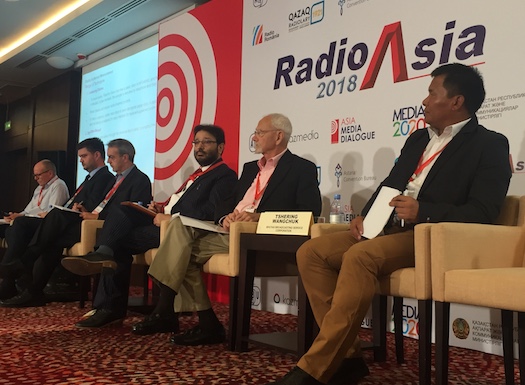In a session on audience research, moderated by Paul Amos, five experts discussed the latest trends in audience research at the Radio Asia conference.
Alexander Yemelyanov from Kantar TNS Central Asia gave an overview explaining that three techniques are used to measure radio audiences in Kazakhstan: listening diaries, day-after-recall, and increasingly, passive measurement by portable meters – which use a watermark embedded in the audio, and picked up by the meters wherever the listener may be.
People meters have been used for radio and tv measurement in Kazakhstan for about 10 years. However, Yemelyanov said using big data is not enough, you must use use it together with traditional data collection methods – i.e. mixed methodology is the future.
Steve Ahern, CEO of Ahern Media & Training, suggested that we don’t have to worry about radio dying. In fact radio and audio have survived, and are delivered in new ways, and there’s new optimism for the future. People want to listen because the pictures are better. It’s far more personal and versatile than other media, and so we should help listeners to both make sense of the world, and to help them escape from the world. But on the practical side, over-reporting of audience figures particularly of online platforms is rife, and there is not consistent methodology in collecting data.
Fayyaz Sheheryar, Director General of All India Radio says that research in India shows that radio there has to meet the needs of “the last man”. That is wherever they are, whichever of the 23 languages they may speak, and in order to deliver the principles of parliamentary democracy to the entire population. He said they listen very carefully to their audiences, but there is a tussle between public and private audiences who require different things from their research.
Drew McDaniel, Professor & Director of the School of Media University at Ohio University said that traditional research relies on being reflective of the overall audience which can be difficult. Now big data can provide better insights not only into what they are listening to, but what else can we know about who our listeners are? But how do we overcome the imperfections of big data. We can find out the size of the audience, but why are they tuning in or tuning out? A combination of technologies may be better suited to give a complete picture.
Tshering Wangchuk, CEO, BBSC Bhutan says that the broadcaster cannot afford to do fixed research, but listens carefully to anecdotal research from the audience about the best mix of news and programming. Their challenge is to on the one hand offer an alternative to the international broadcasters or services like Twitter for those in the cities, but on the other hand to provide a completely different type of service for the rural population who need a very local service.
Krill Volkov from Astana Radio said that knowing the audience is so important for every radio station. Currently their main audience is 20-40, and that’s the focus of the programming on their station. They adjust their programming to meet the feedback from the audience, and react to the rating information, but continue to position ourselves as a government radio station, with interesting and suitable programmes for the audience.
Moderator Paul Amos from Xtra Insights said a mix of different research methodolgies must be used, but that big data must be contextualised. Different countries and broadcasters require different information from research, whether it’s simply numbers or more detailed analysis of programming.
Reporting: James Ross

